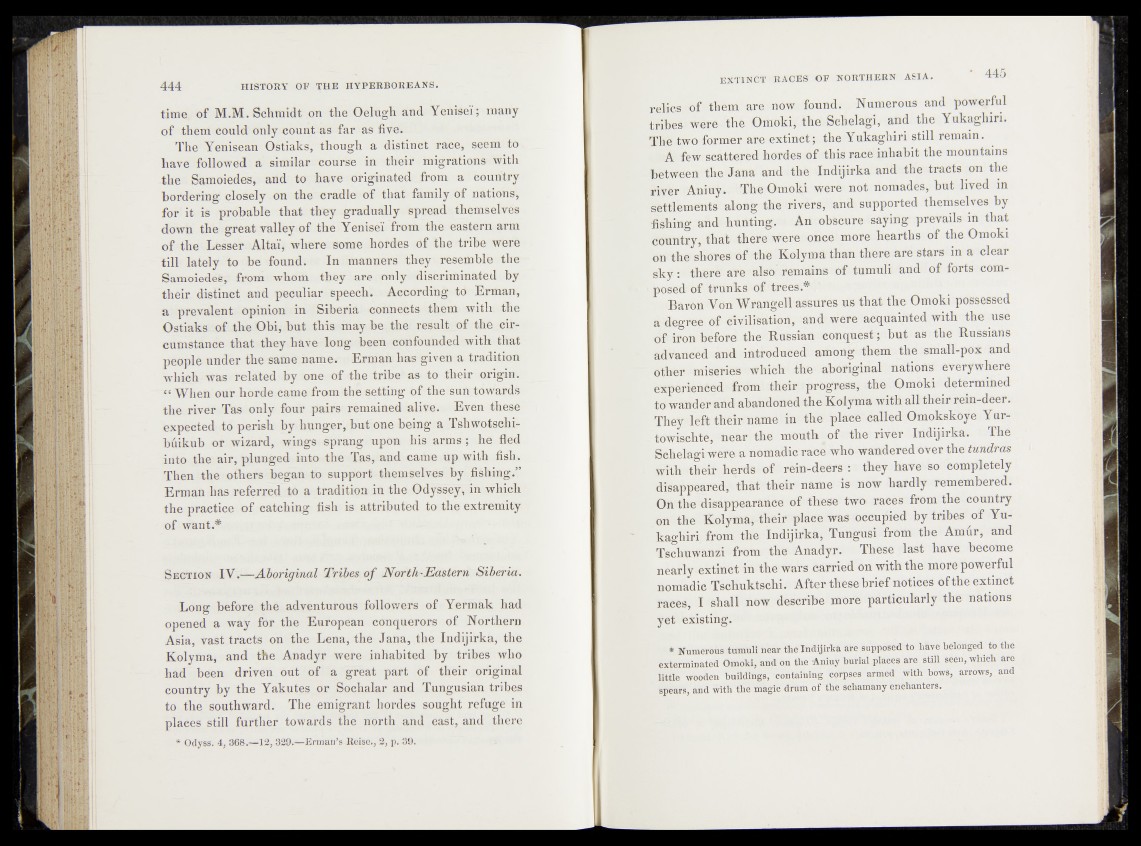
tittle of M.M. Schmidt on the O el ugh and • Yehfoei'; '<mrany
of them could Only count as far as five.
The Yenisean Ostiaks, "though a distinct race, seem to
have followed a similar course in theiT migrations with
the Samoiedcs, and to hare originated from a ’ country
bordering closely on the cradle of that family of nations,
for it is probable that they gradually spread themselves
down the great valley of the Yenisei from the eastern arm
of the Lesser Altai, where some hordes of the tribe were
till lately to be found. In manners they resemble the
Saffioiefleip from whom they are only discriminated by
their distinct and peculiar speech. According to Erman,
a prevalent opinion in Siberia connects ithem with the
Ostiaks. of the Obi, hut this may. he the result of the circumstance
that they have long been confounded with that
people under the same name. Erman has given a tradition
which was related by one of the tribe as to their origin.
“ When our horde came from the,setting of the sun tiwardfS
the river Tas only four pairs remained alive. Even these
expected to perish by hunger, but one being a, Tshwotsehi-
hdikub or wizard, wings sprang upon his arms; he fled
into the air, plunged into the Tas,aodcame up with fish.
Then the others began to support themselves by fishing^
Erman has referred to a tradition in the Odyssey, in which
the practice of catching fish is attributed to the extremity
of want.*
S ection W .—Aboriginal Tribes of North-Eastern Siberia.
Long before the adventurous followers of Yermak had
opened a way for the European conquerors of Northern
Asia, vast tracts on the Lena, the Jana, the Indijirka, the
Kolyma* and the Anadyr were inhabited by tribes who
had been driven out of a great pact of their original
Country by the Yakutes or Sochalar and Tungusian tribes
to the southward. The emigrant hordes sought refuge in
plaees still further towards the north and east, and there
* Odyss. 4, 368.—12, 329.—Erman’s -Reise., 3, p. 39.
relics-of them are now found. Numerous and powerful
tribes-were-the Omoki, the Schelagi, and the Yukaghin.
The two-former are extinct; the Yukaghiri still remain.
A few scattered hordes of this race inhabit the mountains
between- the Jana and the Indijirka and the tracts on the
river Aniuy. The Omoki were; not nomades, but lived in
settlements along the rivers, and supported themselves by
fishing and hunting. An obscure saying prevails in that
Country, that there were once more hearths of the Omoki
on the. shores of the Kolyma than, there are stars in a clear
sky: there are aW remains of tumuli and of forts com-
« posed of tMnkS of!trees.* / _
Baron Von Wrangell assures US that, the Omoki possessed
a,degree-of civilisation, and were acquainted with the use
of-iron before the Russian conquest; hut as the Russians
advanced and introduced among them the small-pox and
other miseries which the aboriginal nations everywhere
experienced from their progress, the Omoki determined
to wander and abandoned the Kolyma with all their rein-deer.
They left their name in called Omokskoye Yur-
. towisehte, near the mouth ^of the rive-r Indijirka. The
ScheMgi"#ere a nomadierace who wandered over the tundras
with their herds of rein-deers : they have so completely
disappeared, that their name is now hardly remembered.
On the disappearance of these two races from the country
m the Kolyma,-thei# place was occupied by tribes of Yu-
kagbiri from the Indijirka, Tungusi from the Am dr, and
Tschawafili from the Anadyr. These last have become
nearly extinct in the wars carried on with the more powerful
nomadic Tschuktschi. After these brief notices of the extinct
races, I shall now describe more particularly the nations
yet existing.
* Numerous tumuli near the Indijirka are supptfsfed’io hktfe belonged to the
exterminated Omoki, and on the Aniuy burial .places are still seén, w^ch are
fettle -wooden buildings, containing corpses armed with hows, arrows, and
Spehrs, and with the magic dfünh of%> schatnany ehéhanters.